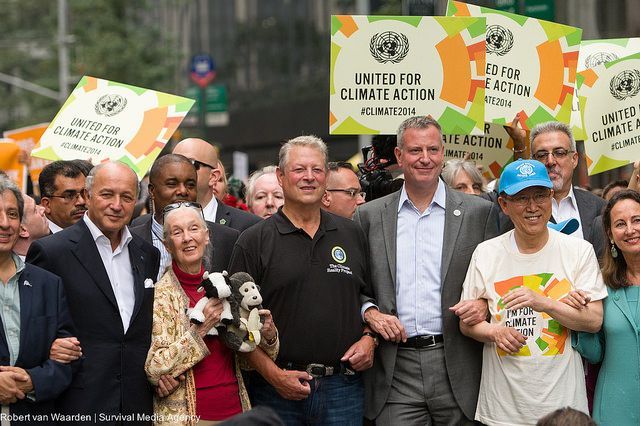Two different narratives on the outcome of the People’s Climate March
by Milos Kovacevic and Johanna Pellus
The figures vary — 100,000 according to some, over 300,000 according to others — but a human wave of protesters converged on New York on Sunday and Monday in an ostensible rejection of the environmental status quo.
Over 1,500 organizations were present in the city for the eve of Tuesday’s UN summit on climate change, where world leaders will meet to discuss strategies and possibilities on mitigating the human impact on the environment. It is seen by some as an attempt by the UN to salvage the ineffective Kyoto protocol and come up with a new working model.
Two Montrealers – Marcus Peters and the Students’ Society of McGill University (SSMU) Environment Commissioner Kristen Perry – formed part of their city’s delegation. Peters and Perry came to two different conclusions.
“The trouble with climate change is that it’s such a large-scale problem in terms of scope and timeframe that it is easy to push it out of our day-to-day lives,” said Perry on the long-term effects on people’s consciousness of the massive effort of the march, which included participation from Hollywood celebrities, intellectuals, and political figures like New York Mayor Bill de Blasio.
According to Peters and Perry, the groups converging in New York each represented their own particular situations, with Canadians in particular focused on tar sand development and divestment.
Perry called Canada’s recent climate and environmental policies as regressive and ‘dreadfully insufficient.’ To her, a nation like Germany with its progressive energy policies is a more admirable example.
The apparent success of the march belies a visible dissatisfaction from those who see the whole exercise as a temporary grab of headlines without substance. For these groups the confluence of interests waters down the strength of a common goal, and the movement on display at the march was a tangled thread more than a tightly woven weft without commonality in goals and demands.
Perry sees strength in a broadening of the appeal, and welcomed increased participation by the masses. The trick now may not be garnering attention as making practical use of it.
Undoubtedly, the march did display certain undeniable truths. One was that climate change is becoming this generation’s rallying call.
“Policy-makers also need to be cognizant about the reach and effects of their policies, especially how it is going to affect marginalized communities, including indigenous peoples across the world and those who are on the front lines of the effects of climate change,” said Perry, whose concerns highlight the second major shift from an urban, Western concern to something equally involved with its effect on non-white, non-Western, often local or aboriginal communities.
“The main challenge that we need to figure out is how to use our knowledge to galvanize action at multiple levels, and include all affected parties in a meaningful way as we work toward mitigation and adaptation,” Perry said.
Others see it as a clever PR stunt by the multitude of international companies who’ve financed an event whose raison d’etre is very much antithetical to corporatism and the bottom line.
“In a lot of ways, it felt sanitized, choreographed, and overdone,” said Peters. “After retrospectively reading some articles on the march, I learned about how the founders, despite claiming to look for an ‘Occupy-style protest’ actively undermined the ‘Flood Wall Street’ demonstration scheduled to take place the following day,” he said, referring to the more confrontational march on Monday which encouraged aggressive protesting. Indeed, several dozen protesters were arrested on Monday in the aftermath of Flood Wall Street, according to The Guardian.
“Despite the fact that I have so many misgivings about the way the march turned out, it was nevertheless a symbolic move around the most important issue of our generation. Protests aren’t all about the day you hit the streets, there’s a lot of work that goes on behind the scenes, and it’s that kind of work that instigates change,” Peters said.
Both Peters and Perry unanimously agree that the opportunity given to them by meeting other groups and learning from their experiences and strategies was perhaps the greatest boon the event could offer.
“That’s part of the beauty of the dispersed structure of the organizing for the march and the events surrounding it,” Perry said.
“Regardless of the impact interest groups may have had on the organizing in general, we made some very real connections with other environmental groups from around the world,” said Peters. “Protests aren’t all about the day you hit the streets, there’s a lot of work that goes on behind the scenes, and it’s that kind of work that instigates change.”
